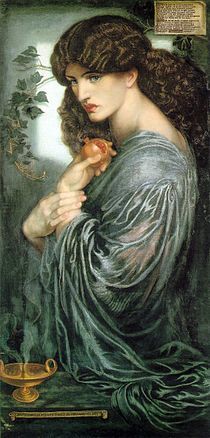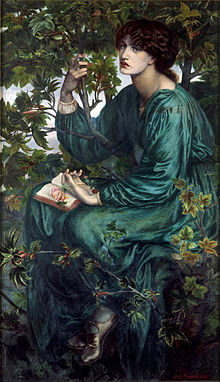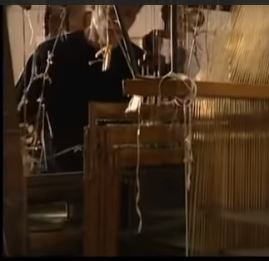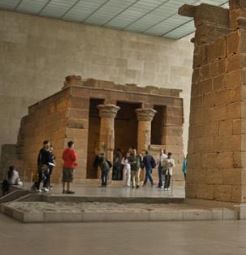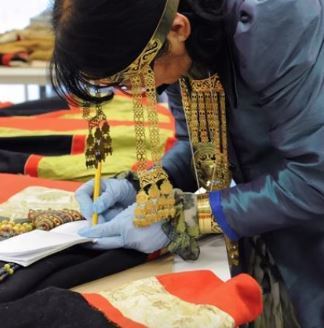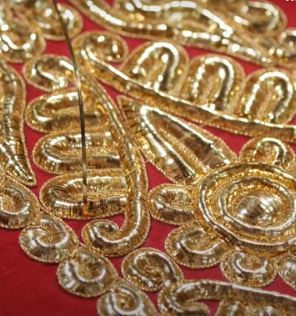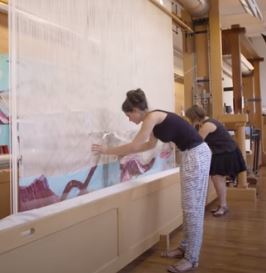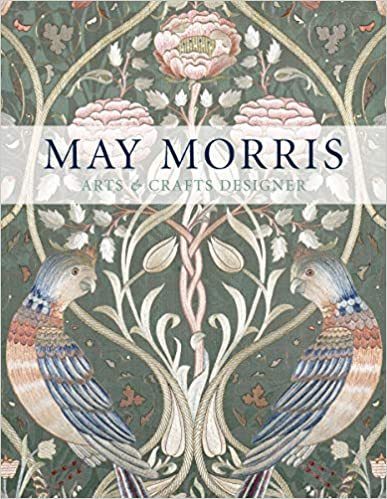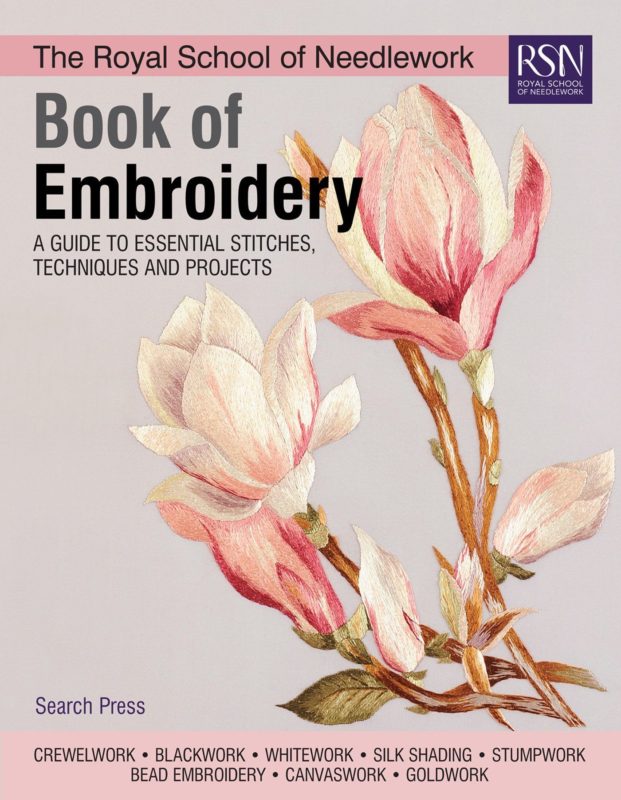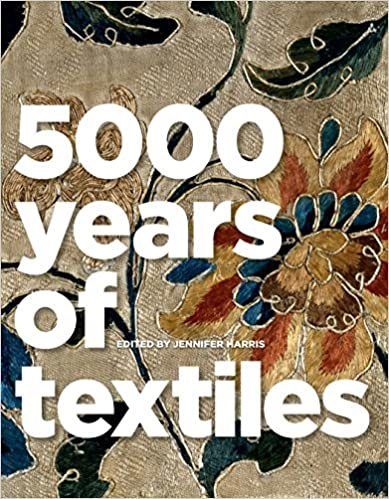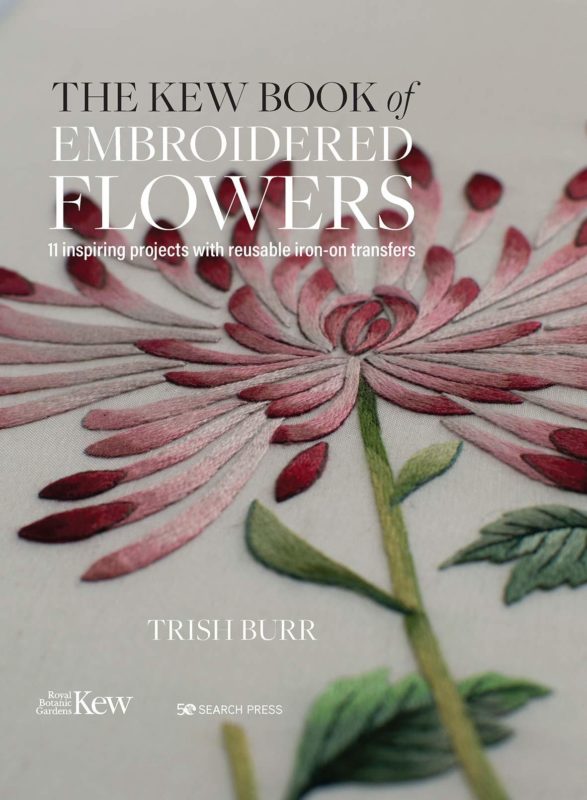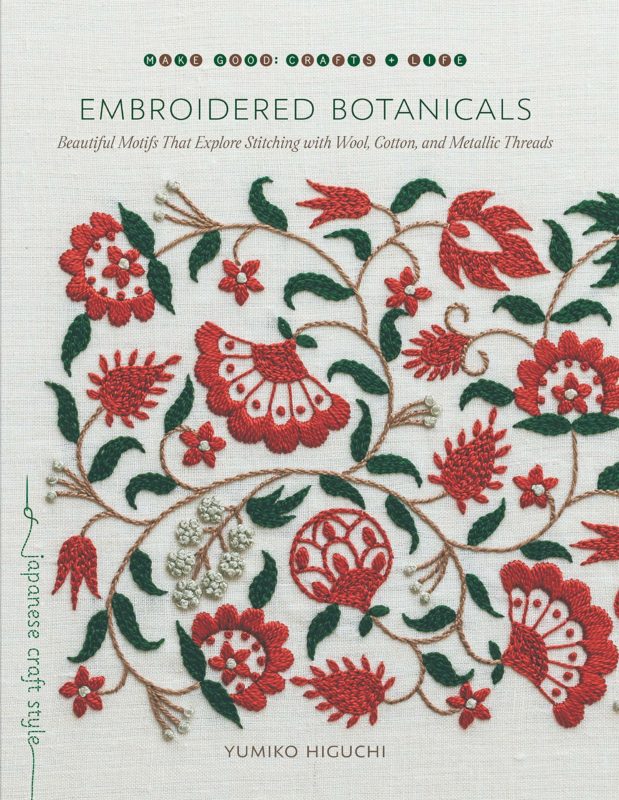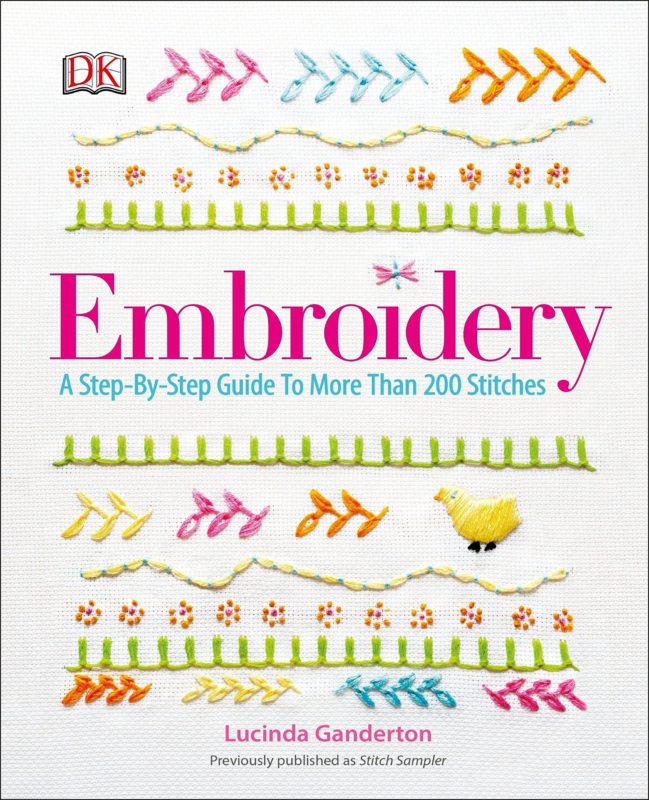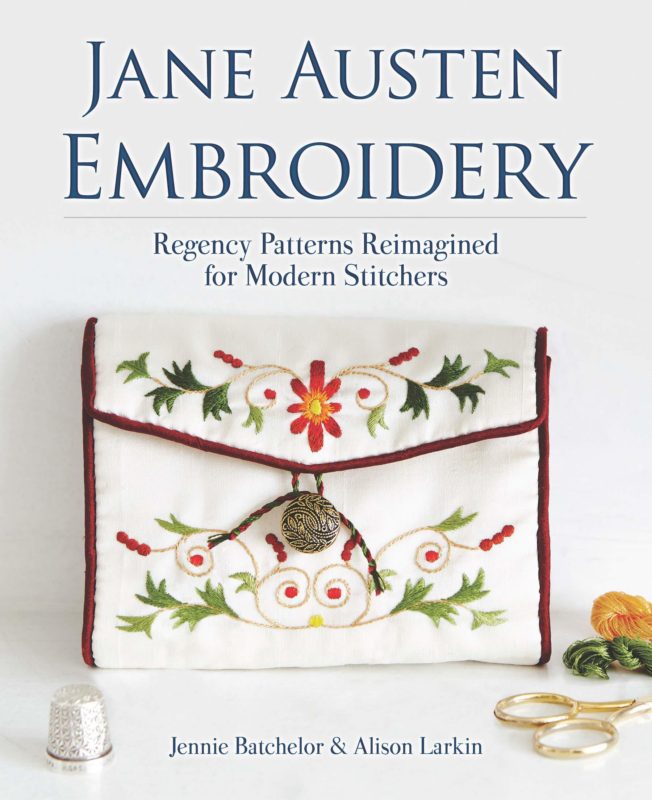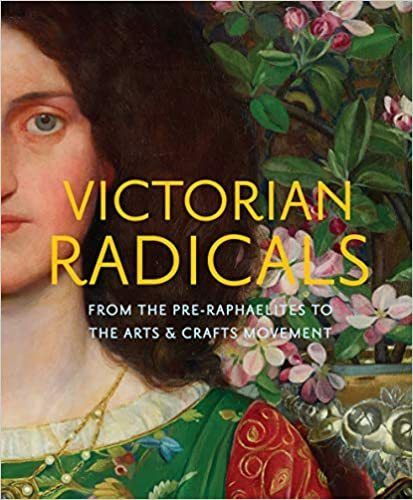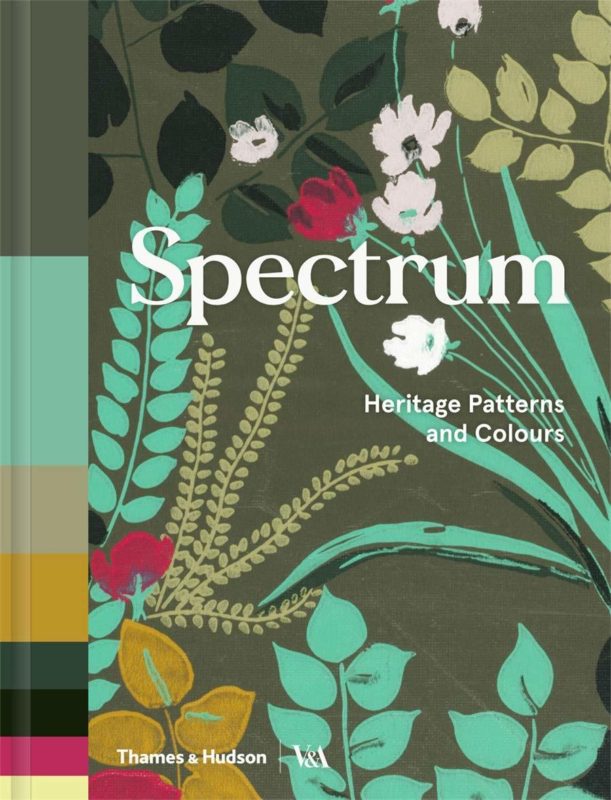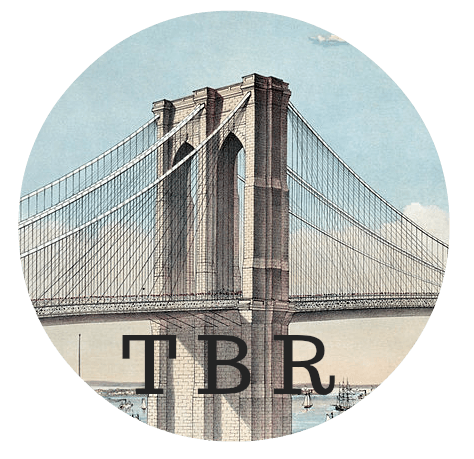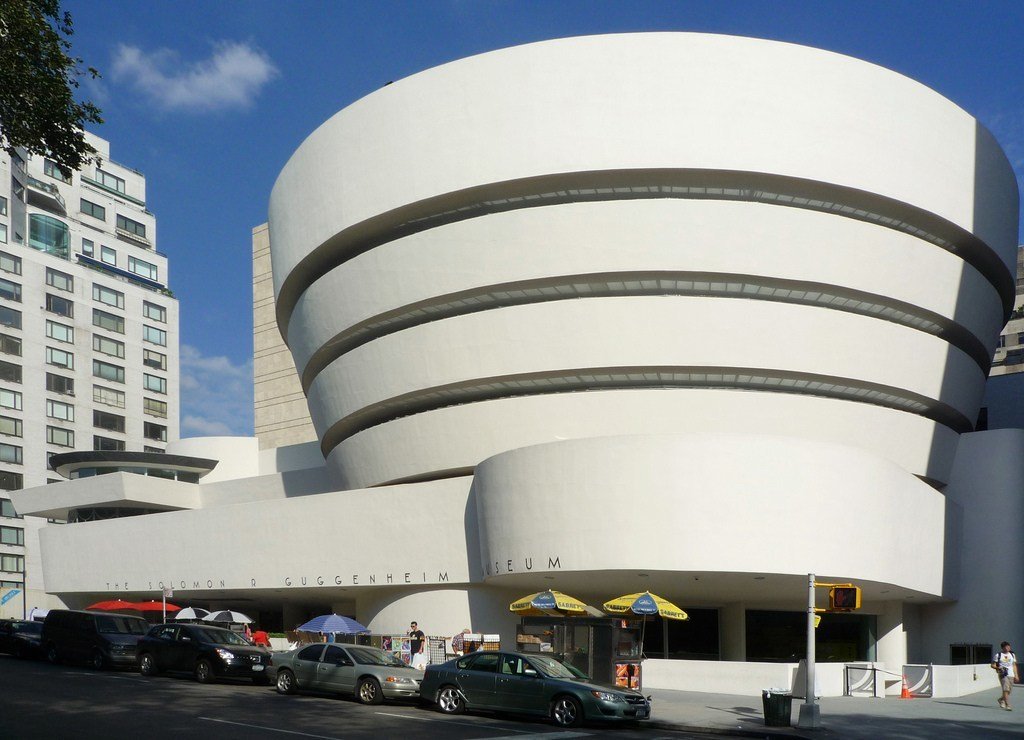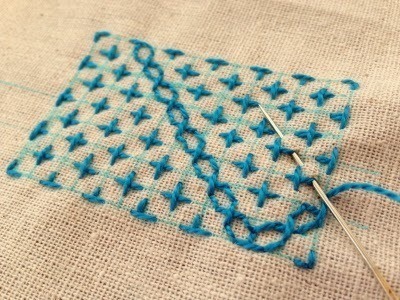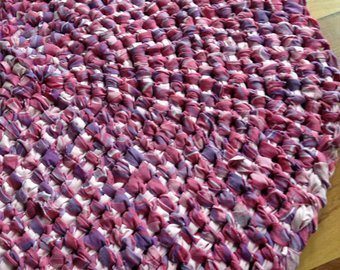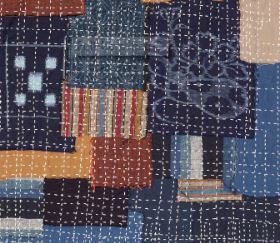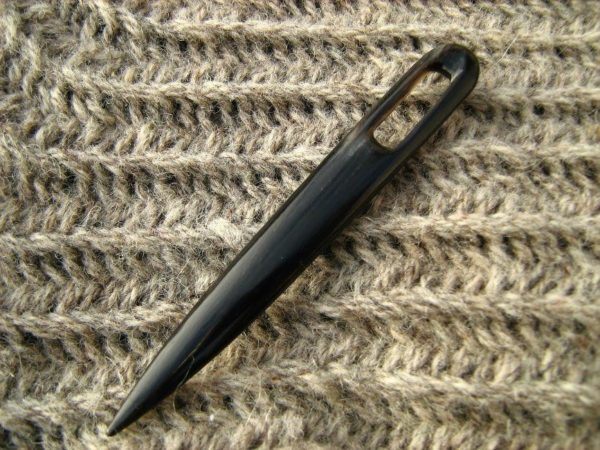May Morris
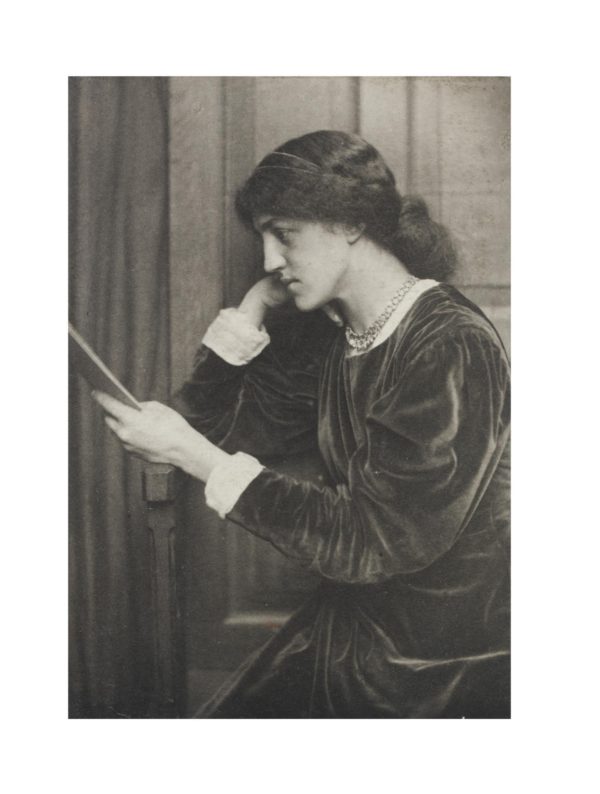
Portrait of May Morris by Frederick Hollyer, circa 1890. Photo via © Victoria and Albert Museum, London
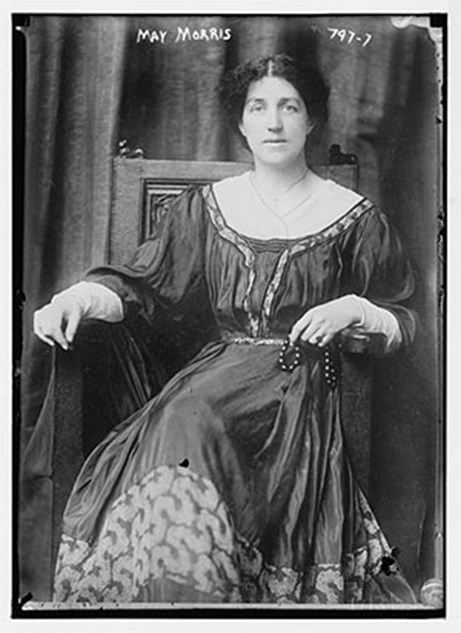
Portrait of May Morris via Library of Congress Prints and Photographs Division Washington, D.C.
May Morris (1862 - 1938) and her father William Morris (1834 – 1896) were both significant figures of the British Arts and Crafts Movement. While William Morris's place in art history is well established, May's place is less well known. This is changing, thanks to a special exhibition of her work that was organized by the William Morris Gallery, and two recently published books on her life and work.
May was born into a creative family, setting the tone for her life's work. William Morris is known for his involvement in the Arts and Crafts Movement. The Movement was focused on hand-made and hand-crafted items, rejecting the mass produced products of the Victorian period. Morris is widely acknowledged for his masterful designs which feature images of organic growth - of leaves, branches, and flowers. He is also known as a craftsman, designer, poet, printer, socialist, novelist, and environmentalist. His legacy remains important today.
Jane Burden Morris, May's mother, was an embroiderer. She was also a muse and a model to her husband and to Dante Gabriel Rossetti, the English painter, poet, and illustrator who founded the Pre-Raphaelite Brotherhood. Elizabeth Burden, May's aunt, was an embroiderer and teacher.
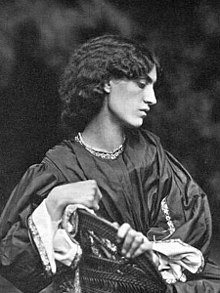
Portrait of Jane Morris by John Robert Parsons, copied by Emery Walker Ltd., July, 1865.
From the series copied by Emery Walker Photo via National Portrait Gallery
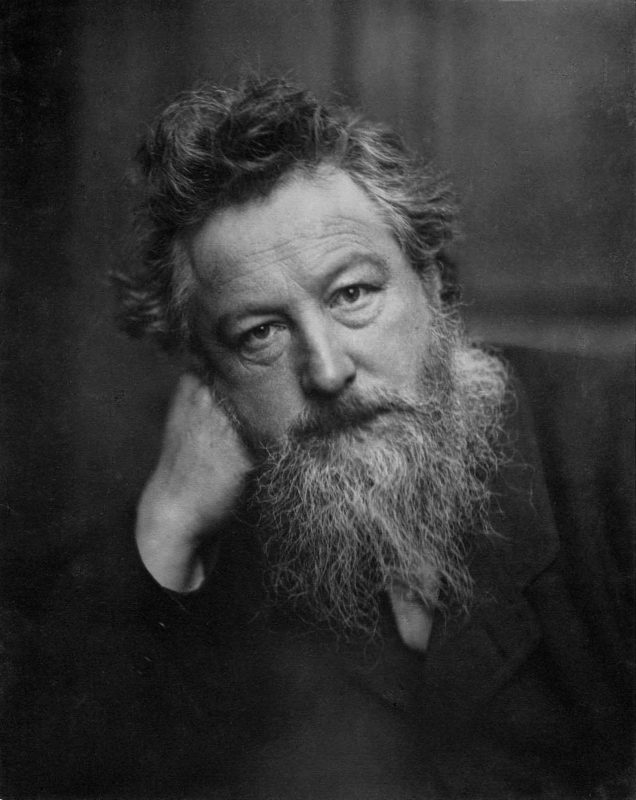
Portrait of William Morris by Frederick Hollyer, 1888
In 1861, William Morris founded the firm Morris, Marshall, Faulkner & Co., along with the artists Edward Burne-Jones and Dante Gabriel Rossetti, the architect Philip Webb, and others who were responding to the shoddy practices of much of Victorian manufacturing. Morris designed wallpaper, fabrics, tapestries, furniture, and stained glass windows. He assumed total control of the company in 1875, and renamed it Morris & Co.
May Morris was born in 1862. Her mother and aunt taught her to embroider; her father taught her textile design. At age 16, she enrolled at the National Art Training School (NATS) in South Kensington, London - the precursor of the Royal College of Art. She was part of the first generation to study crafts in art schools such as the NATS. Her focus in school was on textiles and embroidery, with a special interest in Opus Anglicanum - a form of fine needlework developed in medieval England that was used primarily for making church vestments.
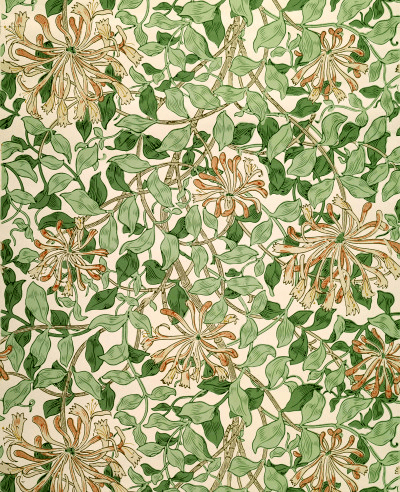
'Honeysuckle' Wallpaper designed by May Morris, 1883. Woodblock print on paper; hand-printed wallpaper decorated with honeysuckle. Printed by Morris & Co., hand-printed by Morris & Co., 1883. Photo via © Victoria and Albert Museum, London
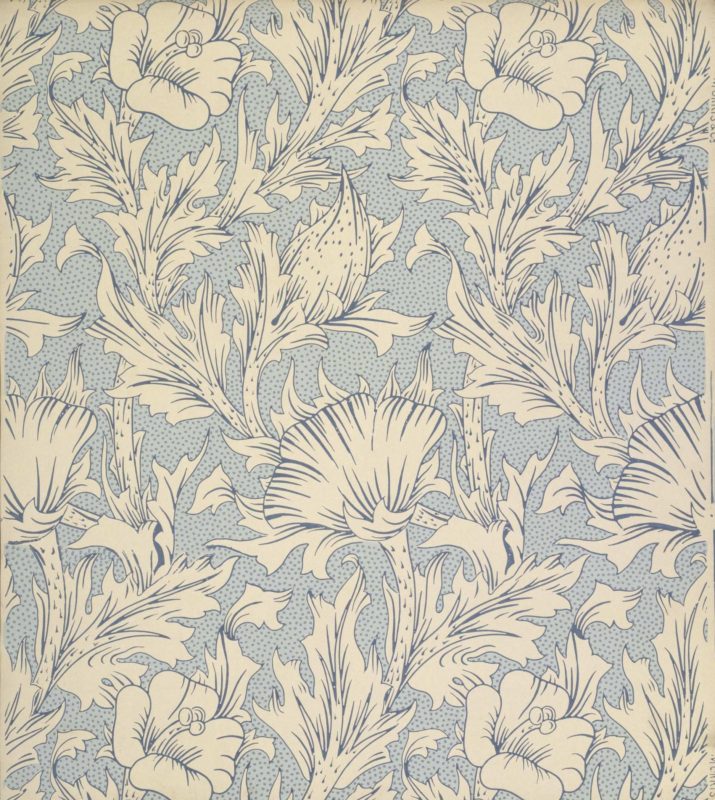
Specimen of 'Horn Poppy' wallpaper, a design of poppy flowers and foliage; Color woodblock print on paper; Designed by Mary (May) Morris; Published by Morris & Co.; Printed by Jeffrey & Co.; Part of a pattern book of Morris & Co. patterns (E.633-858-1915); England; 1885. Photo via © Victoria and Albert Museum, London
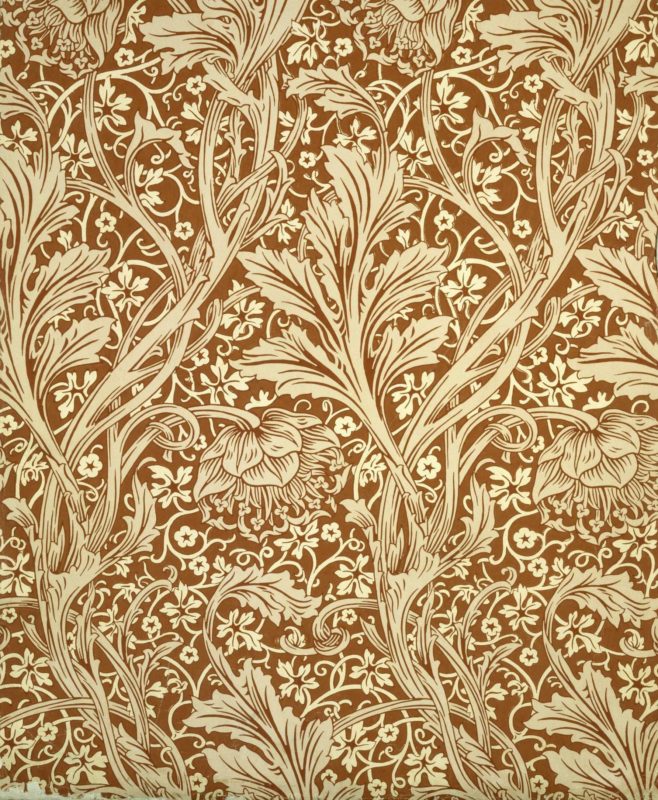
Designed by May Morris: Specimen of 'Arcadia' wallpaper, a pattern of intertwined flowers and foliage, cream and brown; color woodblock print, on paper via Mary (May) Morris; Part of 'Volume 2', a pattern book containing 27 Morris & Co. patterns from 1882-96 (E.530-608-1919); England; ca. 1886. Height: 68.5 cm size of volume, Width: 53.3 cm size of volume. Photo via © Victoria and Albert Museum, London
Arts and Crafts in the Victorian Age
The Arts and Crafts Movement flourished in Europe and North America between about 1880 and 1920.
“The Arts and Crafts movement was an international trend in the decorative and fine arts that developed earliest and most fully in the British Isles and subsequently spread across the British Empire and to the rest of Europe and America.
Initiated in reaction against the perceived impoverishment of the decorative arts and the conditions in which they were produced, the movement flourished in Europe and North America between about 1880 and 1920. In Japan it emerged in the 1920s as the Mingei movement. It stood for traditional craftsmanship, and often used medieval, romantic, or folk styles of decoration. It advocated economic and social reform and was anti-industrial in its orientation. It had a strong influence on the arts in Europe until it was displaced by Modernism in the 1930s, and its influence continued among craft makers, designers, and town planners long afterwards.
The term was first used by T. J. Cobden-Sanderson at a meeting of the Arts and Crafts Exhibition Society in 1887, although the principles and style on which it was based had been developing in England for at least 20 years. It was inspired by the ideas of architect Augustus Pugin, writer John Ruskin, and designer William Morris. In Scotland it is associated with key figures such as Charles Rennie Mackintosh.” Wikipedia
In 1878, at age 23, May became the Director of the Embroidery Department of her father’s company. She managed the embroidery division until his death, in 1896. From 1885 until 1896, the Morris & Co. embroidery workshop operated from May Morris's house at Hammersmith Terrace. After 1896, it may have been run out of the Oxford Street shop, using craftspeople to make the orders. As Director of the Embroidery Department, May supervised the production of items commissioned by clients and made in the Morris & Co. style - overseeing the making of altar cloths, portières, fire screens, cushion covers, tablecloths, table runners, wall hangings, card cases, sachets, and bed covers.
As a designer and embroidered who had studied historical needlework as an art student, May elevated embroidery to an art form. She worked with needlework that emphasized freehand stitching and delicate color shading. Her art embroidery was in sharp contrast to the style of Berlin wool work, which was popular until the 1880s.
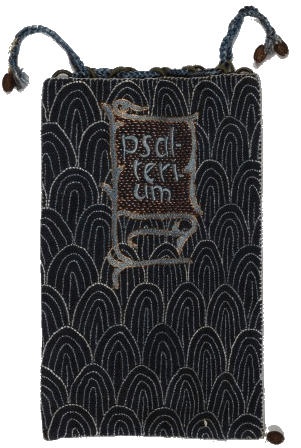
Embroidered book bag by May Morris and Jenny Morris c. 1880s - 1890s. Hand embroidered silks and gold thread on linen. 22.8 x 15.4 cm. "This bag was designed and made by William Morris's two daughters, May and Jenny. It was designed by May to contain a 'Psalter' (a book of psalms), from William Morris's extensive collection of medieval manuscripts. The bag is made of indigo linen and embroidered by Jenny in silk with the word "Psalterium" in Gothic script. Stitches include back stitch, stem stitch, long & short stitch, loop stitch, satin stitch, couching and buttonhole stitch; round edges with words filled in with chain stitch; pomegranate is padded laid work; surface couched in gold thread." William Morris Gallery Photo © William Morris Gallery, London Borough of Waltham Forest
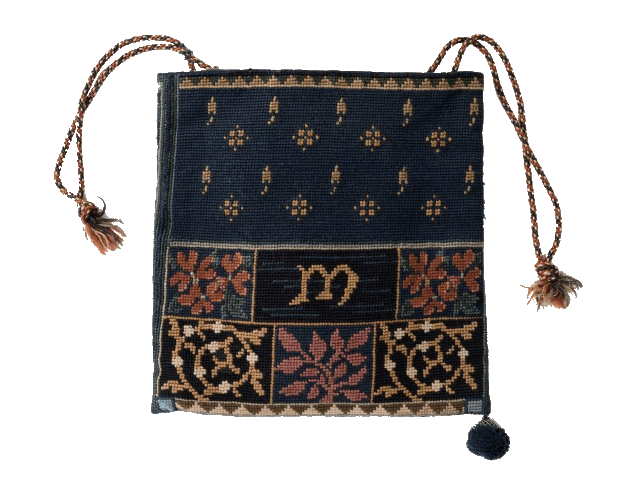
Embroidered bag by May Morris c. 1932. Wool on canvas. Photo © William Morris Gallery, London Borough of Waltham Forest
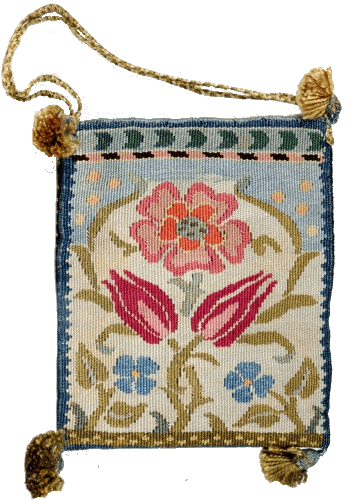
Small Evening Bag designed by May Morris. © William Morris Gallery, London Borough of Waltham Forest
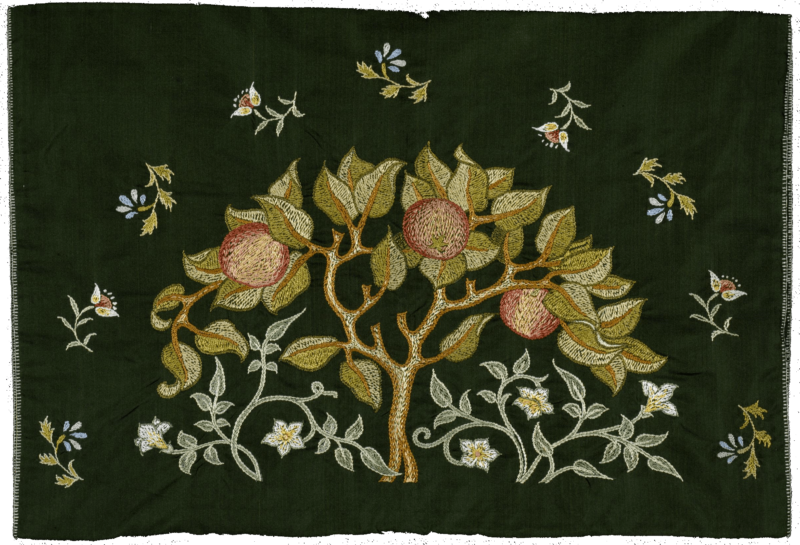
Nightdress sachet embroidered silk, with Apple Tree. Designed by May Morris for Morris & Co. Colored silks on green. Said by donor to have been embroidered by Caroline Phillips, Lady Trevelyan. ca. 1890-1892 Photo via © Victoria and Albert Museum, London
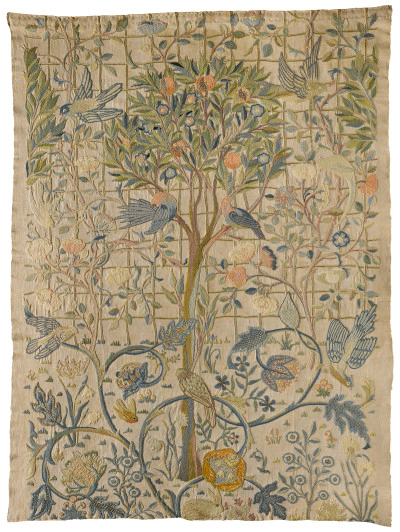
Embroidery design by May Morris; worked by May Morris and Theodosia Middlemore for Melsetter House, Orkney, c.1900
The Importance of Embroidered Textiles for Morris & Co.
“Embroidered textiles were the first furnishings designed and produced by William Morris, enabling him to decorate his homes with the historically inspired textiles he desired, and providing an outlet for his intellectual and physical need to make things by hand.
After Morris’s interests moved on to designing and manufacturing other products, the Morris & Co. embroidery studio, managed by his daughter May from 1885 to 1896, functioned as one of the most commercial areas of the company, producing kits and finished embroideries, which were popular with the middle classes and wealthy aristocrats and business people.
Embroideries available ranged from cushions and tea cosies to panels for folding screens, and large scale decorative hangings. May Morris introduced many new designs, and was responsible for the success of the embroidery department, as a highly skilled designer and embroiderer, and effective manager." V & A Museum
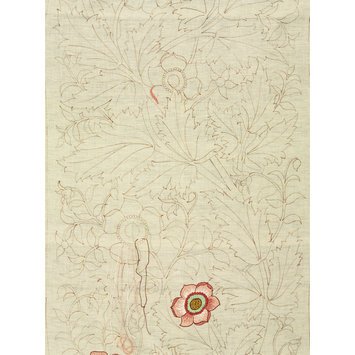
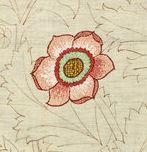
"Embroidery kit, Morris & Co., 'Anemone' design, purchased c.1904. Cotton ground or 'Manchester cloth,' painted with design, partly worked with silk thread. Worked areas with stem stitch, darning stitch, satin stitch and laid work. Ground fabric edged on three sides with a double hem, with tacking stitches. Selvedge at left hand edge." Image via V&A Museum
William Morris is known mostly for his wallpaper designs today. But the embroidered items and embroidery kits, created under May's guidance, were a significant source of income for the company.
"As a screen panel, 'Anemone' appears nine times in the Morris & Co. embroidery workroom daybook in the NAL collections (MSL/1939/2636), in which May Morris listed all embroidery work commissioned for the years 1892-96. This indicates the continued popularity of the embroidered screen panels and this particular design. This 'started' panel, including the cotton ground, painted design, and coloured silks, with areas completed so that the recommended technique could be followed at home, cost £1 and one shilling in 1896. In this case, the panel was never worked, and the threads were also given to the Museum (T.159-2016 to T.190-2016). The embroidery kit was passed to the donor, Jill Ford, by her mother, Elsie Winifred Couper (1906-1948), the daughter of the Scottish civil engineer Benjamin Blyth II (1849-1917).” V & A Museum
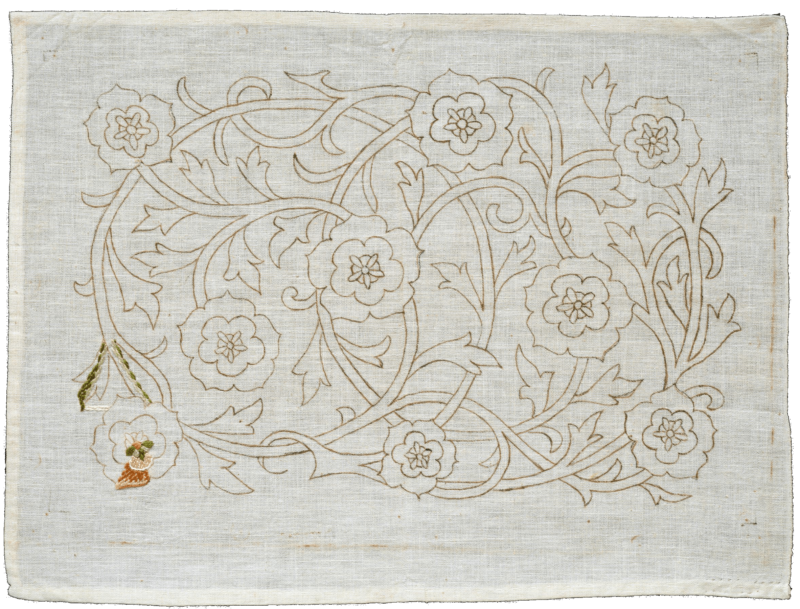
Panel, Small Rose embroidery kit (started) with embroidered cotton in silks, designed by May Morris for Morris & Co., England, ca. 1890. Width: 15 in, Length: 19.5 in. Worked in darning stitch, stem stitch, long and short stitch and satin stitch. Photo via © Victoria and Albert Museum, London
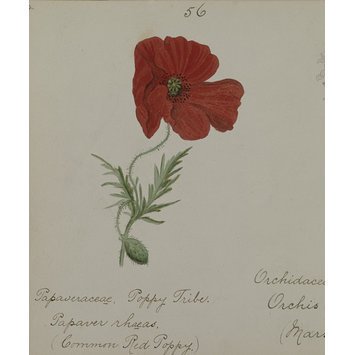
English Wild Flowers gathered near Newbury Berks and painted by Mary Elizabeth Morris (Sketchbook) circa 1890. Watercolor and pencil, on wove paper, bound in half-calf and red cloth, lettered in gold. Photo via © Victoria and Albert Museum, London
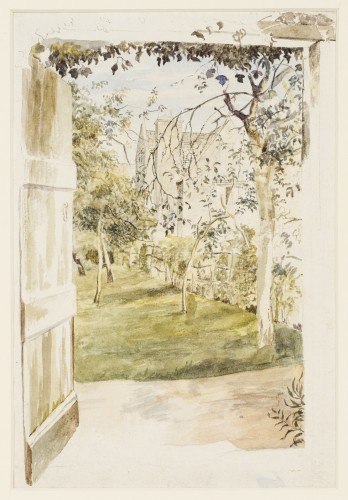
May Morris pencil and watercolor on paper: View of Kelmscott Manor from the Old Barn (c.1880s). Photo © William Morris Gallery, London Borough of Waltham Forest
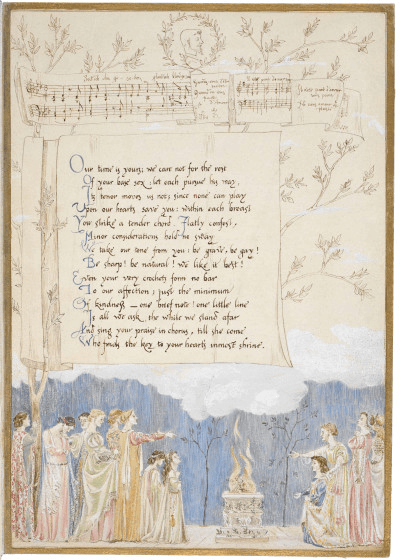
May Morris Valentine to George Bernard Shaw, 1886. Pen and ink, watercolor and body color on board. 26.6 x 18.6 cm. Photo © William Morris Gallery, London Borough of Waltham Forest
May taught at Hammersmith College of Art, Birmingham School of Art, and the Leicester School of Art, and went on a lecture tour in the United States between 1909 and 1910. She was also active in the Royal School of Art Needlework, which was founded in 1872 under the patronage of Princess Helena, a daughter of Queen Victoria. In contrast to government schools of design for women which were teaching through theory, the school, now the Royal School of Needlework (RSAN), was set up to help students learn needlework through practical, hands-on technical training. Students studied collections of ancient embroidery in the South Kensington Museum in order to better understand and learn the techniques used in historical textile works, and got pragmatic experience through structured apprenticeships.
May’s aunt, Elizabeth Burden, was a chief technical instructor at RSAN. Read more about Elizabeth via the Morris Society.
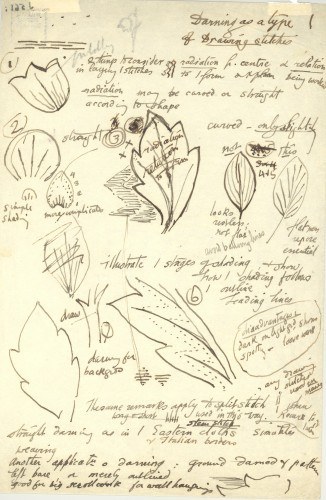
May Morris's notes and sketches for embroidery lectures c. 1899 - 1902. "This lecture note dates from May Morris's time teaching embroidery at Birmingham Municipal School of Art and the Central School of Arts and Crafts in London. The notes and sketches set out her plans for practical lessons, covering design, technique and materials." William Morris Gallery © William Morris Gallery, London Borough of Waltham Forest
Organizing Women Crafts-Makers
London’s Art Workers’ Guild was founded in 1884 by a group of architects and designers, and many of the prominent figures of the Arts and Crafts Movement were among the Guild’s members. The Guild was formed to bring architects, designers, and craftsmen together under the shared idea of the importance of handicraft as machine-driven industry was threatening to replace traditionally hand-crafted pieces made by designer-makers. The movement promoted an aesthetic of high-quality designs inspired by pre-industrial examples, produced by hand.
“The ideas of Pugin, Ruskin and Morris encouraged much questioning of both industrial society and of the state of art and architecture. Men seemed to be separated from the products of their hands; art seemed the product of convention rather than the creative craftsman. One answer was the idea of the Guild, a re-creation of the social organisation of the Middle Ages, those craft societies which, apparently, built the cathedrals.” Art Workers’ Guild History
In 1888 several members of the Guild organized the Arts and Crafts Exhibition Society, which was created to show handicrafts. According to Walter Crane, one of the Society’s founders, the purpose of the Society was:
“We desired first of all to give opportunity to the designer and craftsman to exhibit their work to the public for its artistic interest and thus to assert the claims of decorative art and handicraft to attention equally with the painter of easel pictures, hitherto almost exclusively associated with the term art in the public mind. Ignoring the artificial distinction between Fine and Decorative art, we felt that the real distinction was what we conceived to be between good and bad art, or false and true taste and methods in handicraft, considering it of little value to endeavour to classify art according to its commercial value or social importance, while everything depended upon the spirit as well as the skill and fidelity with which the conception was expressed, in whatever material, seeing that a worker earned the title of artist by the sympathy with and treatment of his material, by due recognition of its capacity, and its natural limitations, as well as of the relation of the work to use and life” Walter Crane "Of the Arts and Crafts Movement"
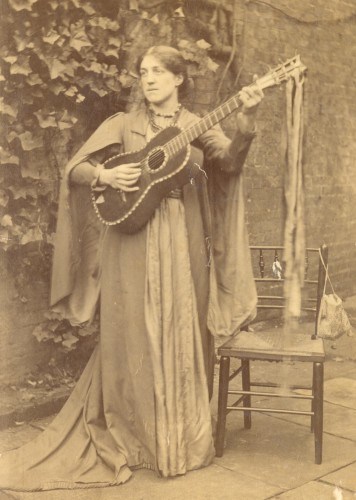
Photo of May Morris (circa 1886). Photo © William Morris Gallery, London Borough of Waltham Forest
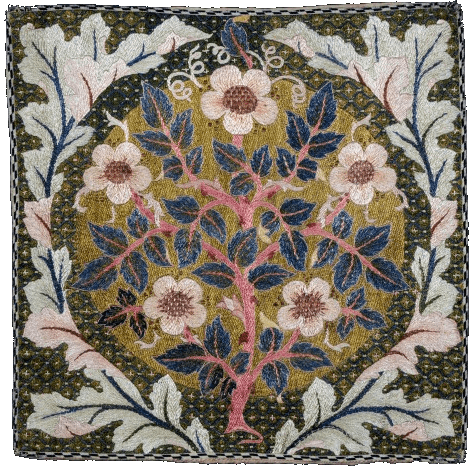
Rose Wreath embroidery (c.1890) 51 x 51 cm "Rose Wreath was designed by William Morris and this example embroidered by May Morris as a cushion cover for her friend Amy Carruthers Tozer. The design was exhibited at the Arts and Crafts Exhibition in 1890." William Morris Gallery
May was involved in the Arts and Crafts Movement throughout the 1890s and 1900s. She exhibited works at the Arts and Crafts Exhibition Society's exhibitions in London in 1893, 1896, 1899, 1903, and 1906, alongside members of craft Guilds - which excluded women.
The male architects, designers, and craftsmen who were involved in the Arts and Crafts Movement had a social network for meeting and sharing ideas in the form of the Art Workers’ Guild. But the the women May worked with were barred from this Guild, which served as a social networking and meeting place.
In 1907, at the age of 45, in direct response to this exclusion, May co-founded the Women’s Guild of Arts with Mary Elizabeth Turner, creating a supportive network for the professional craftswomen of the period. May wanted “to keep to the highest level the arts by which and for which we live” in an “atmosphere of camaraderie.” Members of this women’s group included some of the most prominent figures in the Arts and Crafts Movement: painter Evelyn De Morgan, jeweler Georgie Gaskin, bookbinder Katherine Adams, sculptor Mabel White, watercolourist and engraver Mary Annie Sloane, Agnes Garrett, Mary Lowndes, Marianne Stokes, Evelyn De Morgan, Mary Seton Watts, and Mary J. Newill.
The Women’s Guild of Arts mission was to “keep to the highest level the arts by which and for which we live, to keep ever fresh and vital the enthusiasm, the belief – all the things which are the impetus of human endeavor.”
The Art Workers’ Guild remained a male-only institution until the 1960s, when it finally welcomed its first female crafts-maker – Joan Hassall, a wood engraver and book illustrator.
May was a designer, an embroiderer, a pioneer of art embroidery, a teacher, a writer, a political activist, an historian, a socialist, and a supporter of Women's Suffrage. Today, many of May’s works are held in museums – including the William Morris Gallery, the National Museums of Scotland and Wales, as well as regional museums and galleries, National Trust properties, and university collections.
In the winter of 2017 – 2018, the William Morris Gallery raised funds for a special exhibition of May’s works, which showcased her contribution as a designer of the Arts and Crafts Movement, and recognized her important role in elevating needlework from a domestic craft to an art form.
The exhibit, May Morris: Art & Life, was one of the highest attended in the Gallery’s history. It marked an advance in placing May in art and design history.
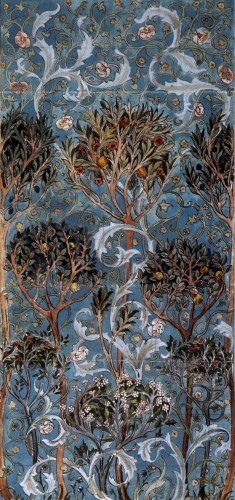
The Orchard - a design for a large embroidered panel. Pencil, watercolor, and ink on paper (c. early 1890s). © William Morris Gallery, London Borough of Waltham Forest
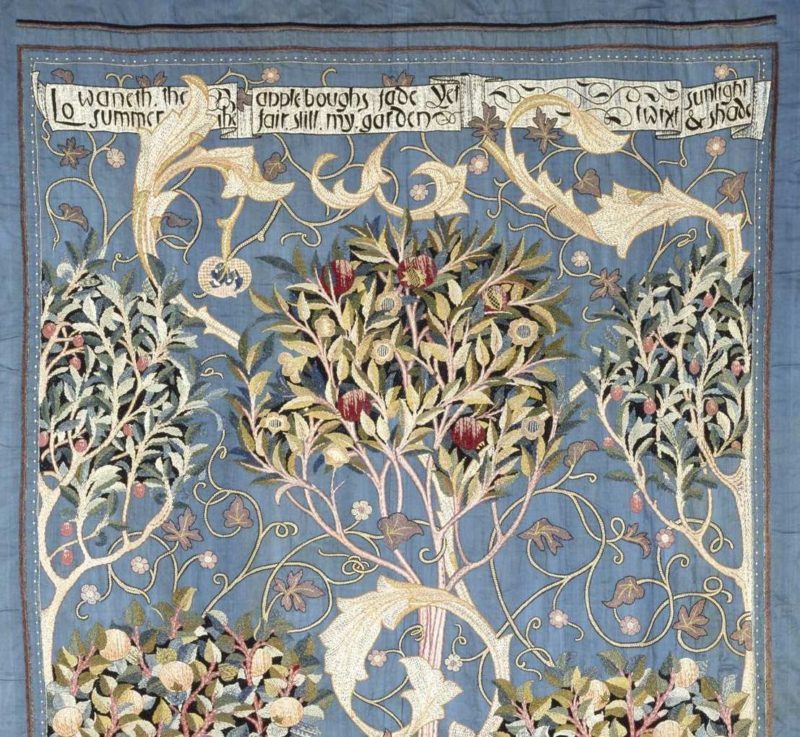
Detail of "The Orchard" or "Fruit Garden" Wall hanging, portière. Silk taffeta in colored silks, and strip of tape, designed by May Morris, embroidered by Theodosia Middlemore, Great Britain, 1894
Embroidered motto: 'Lo waneth the Summer the apple boughs fade Yet fair still my garden twixt sunlight & shade'
signed and dated: 'Theodosia/1894'
Photo via © Victoria and Albert Museum, London

‘Spring and Summer’ panel, designed and probably embroidered by May Morris. c. 1895–1900. Colored silks on silk damask, 130.8 x 71.9 cm. Embroidered motto translates as: “When the summer’s gentle season makes leaves and flowers and field green again."
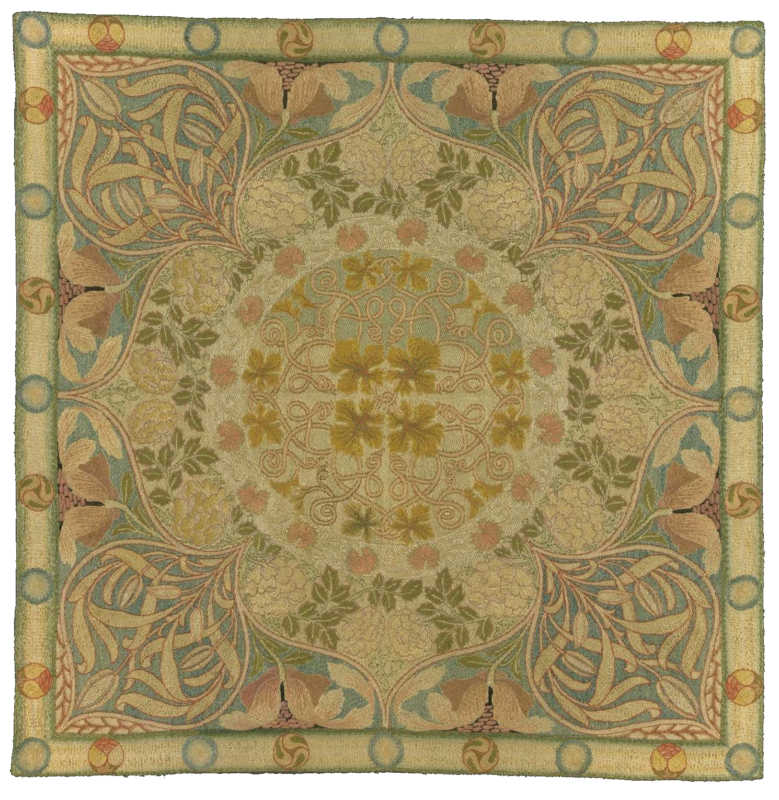
Tablecloth, linen with silk embroidery, probably designed by May Morris, 1896, worked by Mrs Laurence Hodson or in the Morris and Co. workshops, ca.1896, England. Silk thread on linen ground, silk lining.
Worked in darning stitch, stem stitch and satin stitch.
Silk lining attached with running stitch. Height: 108 cm, Width: 108 cm, Weight: 0.58 kg Photo via © Victoria and Albert Museum, London
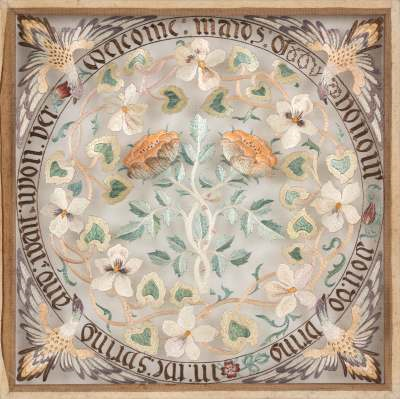
Embroidered wall hanging featuring May Morris’s Maids of Honour design, c.1890s
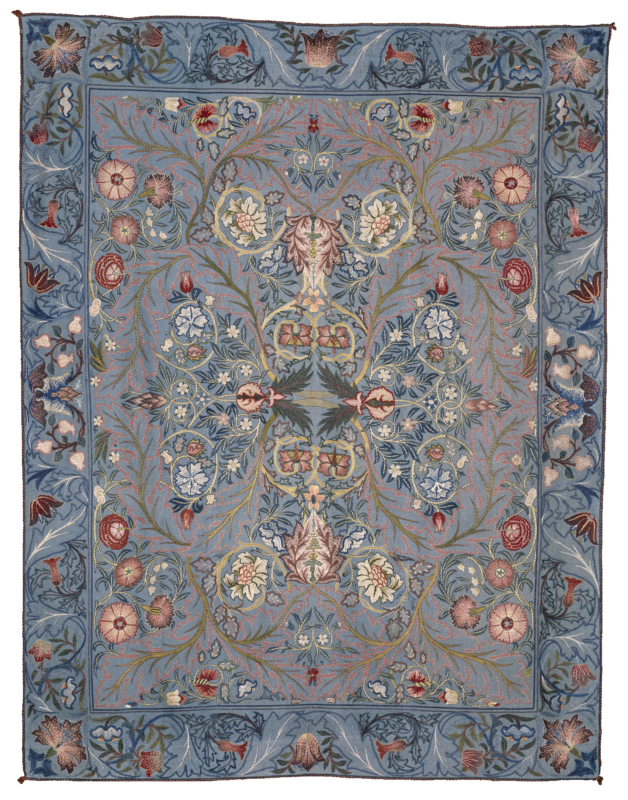
Acanthus Wall hanging depicting acanthus designed by William Morris, ca. 1880. Worked by May Morris and others, c. 1900-1910 (probably). Height: 249.5 cm, Width: 169.3 cm, Weight: 2.7 kg
Felted woolen cloth, colored silk thread, silk cord Photo via © Victoria and Albert Museum, London
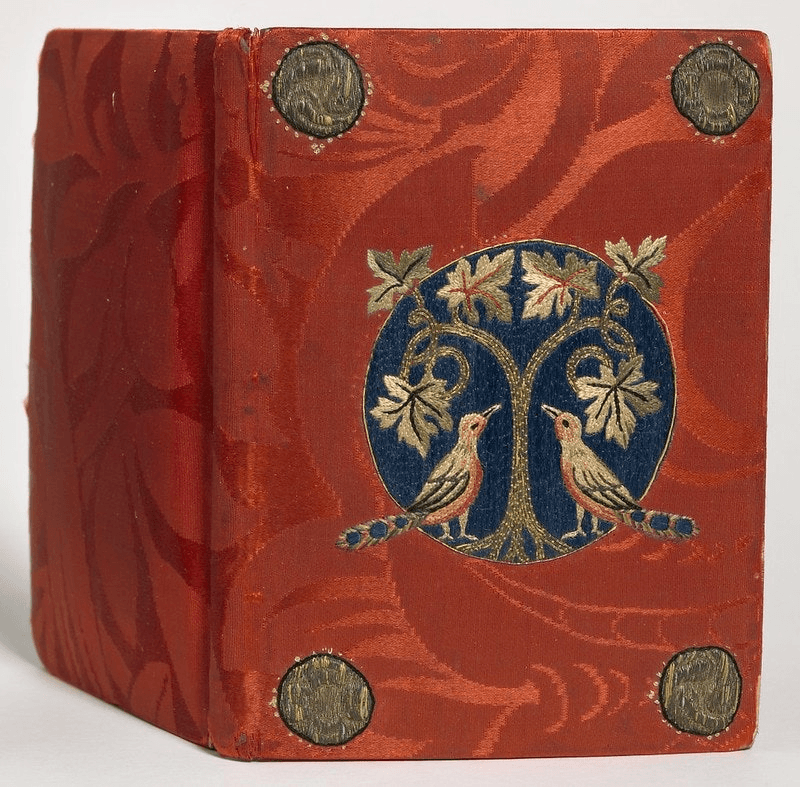
Embroidered book cover to The Tale of King Florus and Fair Jehane, thought to be embroidered by May Morris. Photo © The University of Manchester Library
Resources - Free to Download
In 1893, May Morris wrote a pamphlet, Decorative Needlework. The pamphlet includes a history of decorative needlework, and chapters on different types of stitches and how to make them, with illustrations.
There were originally only 125 copies printed, but the pamphlet is now available for free through the public domain. You can download a copy of it as a .pdf here.
From May's Dedicatory Note:
"These pages are written for and dedicated to those who, without much previous knowledge of the art of embroidery, have a love for it and a wish to devote a little time and patience to its practice. The booklet does not profess in any way exhaustive, but should be useful as a keynote to further study, having been written from practical knowledge of the subject.
I have tried to show that executive skill and the desire of and feeling for beauty, realized in a work of definite utility, are the vital and essential elements of this as of all other branches of art, and that no one of these elements can the embroideress neglect or overlook if her work is to have life and meaning. If she pursues her craft with due care, and one might even say with enthusiasm, however, she will not only taste that keen pleasure which every one feels in creative work, however unpretending, but the product will be such as others will be careful to preserve: this in itself being an incentive to good work. For work done at the demand of fashion or caprice and that done inevitably, that is, for its own sake, are as widely dissimilar as can be: the first being discarded in a month or so as ridiculous and out of date, and the other remaining with us in all its dignity of beauty and fitness, to be guarded as long as may be against the unavoidable wear and tear of time." May Morris
May Morris wrote an article on textile art for the Decorator and Furnisher Magazine, Volume 21, published in 1893. In it, she describes: tapestry stitch, chain stitch, applique, couching, patchwork, and darning. Click here to download a .pdf of her article. The .pdf includes an article on working with color by Alexander D. Grant.
Listen to an interview from BBC SOUNDS In Our Time: William Morris
Produced by Simon Tillotson with: Ingrid Hanson, Lecturer in 18th and 19th Century Literature at the University of Manchester; Marcus Waithe, University Senior Lecturer in English Literature at the University of Cambridge and Fellow of Magdalene College; and Jane Thomas, Professor of Victorian and Early 20th Century Literature at the University of Hull
"Melvyn Bragg and guests discuss the ideas of William Morris, known in his lifetime for his poetry and then his contribution to the Arts and Crafts movement, and increasingly for his political activism. He felt the world had given in to drudgery and ugliness and he found inspiration in the time before industrialisation, in the medieval life which was about fellowship and association and ways of working which resisted the division of labour and allowed the worker to exercise his or her imagination. Seeing a disconnection between art and society, his solution was revolution which in his view was the only way to reset their relationship."
Explore More Textile Art
For Your Library
Below are some books about May Morris, William Morris, and embroidery. Click on the buttons to see more and to purchase on Amazon. Please note that as an Amazon Associate I earn from qualifying purchases (at no extra cost to you).
May Morris: Arts & Crafts Designer by Jenny Lister, Jan Marsh, and Anna Mason
Written by curators of the Victoria & Albert and the William Morris Gallery, this is the go-to book for illustrations of May Morris's work. The book is divided into five chapters―Sketches and Watercolors, Wallpapers and Embroidery, Book Covers and Designs, May Morris and the Art of Dress, and Jewelry and Metalwork―each of which opens with an introductory text, followed by catalog entries with extended captions. Interspersed within the chronological arrangement of objects are feature spreads highlighting particular aspects of May Morris’s work.
Book of Embroidery: A Guide to Essential Stitches, Techniques and Projects by the Royal School of Needlework
From London's world-renowned Royal School of Needlework, this book is a rich source of embroidery techniques, stitches, and projects. Techniques covered include crewelwork, bead embroidery, stumpwork, canvaswork, goldwork, whitework, blackwork,and silk shading. Contains all the trusted, best-selling content from the RSN Essential Stitch Guide series, plus a new section on mounting your finished work.
5000 Years of Textiles by Jennifer Harris
5,000 Years of Textiles is an authoritative reference book, with examples from the Far East to the Americas, from Africa to Scandinavia, and from Egyptian artifacts dating from 3000 BC to the most up-to-date modern craftwork and furnishings. The book includes an expert guide to nine fundamental textile techniques, from rug weaving and tapestry to felt and bark cloth. Each is clearly explained, using line drawings and close-up color details from actual textiles, to show how people from many different traditions have made and decorated cloth through the centuries. Illustrations are drawn from major collections all over the world and include costumes, period interiors, archival photographs, and a vast range of fabrics.
The Kew Book of Embroidered Flowers: 11 Inspiring Projects with Reusable Iron-on Transfers by Trish Burr
Needlework expert Trish Burr's new book contains resuable iron-on transfer papers for embroidery work - just iron onto fabric in preparation to your embroidery project. The embroideries are reworkings of botanical artworks from Kew's Art Collection. There is one 'starter' project to encourage readers to try out the techniques, one large sampler containing eighteen small elements that can be worked individually or as a group, and nine further projects, including a striking spider chrysanthemum, an elegant waterlily and an opulent magnolia. All the projects are shown step by step, with an order of work diagram given where appropriate. The templates are included at full size at the back of the book.
Embroidered Botanicals: Beautiful Motifs that Explore Stitching with Wool, Cotton, and Metallic Threads by Yumiko Higuchi
Japanese artist Yumiko Higuchi is celebrated for her embroidery designs with a Scandinavian flair. In Embroidered Botanicals, Higuchi offers 39 embroidery projects highlighting the distinctive qualities of different threads - wool, cotton, pearl cotton, and metallic. With beautiful photographs, clear step-by-step instructions, and detailed diagrams, this book will be an inspiring guide for those new to embroidery and a fresh and unique offering for more experienced needle-crafters.
Embroidery: A Step-By-Step Guide to More Than 200 Stitches by Lucinda Ganderton/DK
The perfect reference guide to needlework, Embroidery is a comprehensive guide to inspire and inform sewers of all levels. Find advice on which thread, needles, or fabrics work with which techniques, and take a look at an incredible 200 stitches — with levels of difficulty, step-by-step instructions, and ideas on where and how to use them. This practical guide covers sewing tips for dressmaking, needlepoint, and embroidery stitches, with detailed information simply presented in illustration-rich pages.
Jane Austen Embroidery: Regency Patterns Reimagined for Modern Stitches by Jennie Batchelor and Alison Larkin
Jane Austen was as skillful with a needle as she was with a pen, and this unique book showcases rare and beautiful embroidery patterns from her era, repurposed into 15 modern sewing projects. Derived from Lady's Magazine (1770–1832), a popular monthly periodical of fashion, fiction, and gossip, the projects consist of embroidered clothes, accessories, and housewares. Designs include an evening bag, a muslin shawl, an apron, a floral napkin set and tablecloth, and other pretty and practical items with timeless appeal.
These authentic patterns — many of which have not been reprinted in more than 200 years—are enlivened by vivid glimpses into the world of Regency women and their domestic lives. A must-have for every Jane Austen fan, this book is suitable for needleworkers at every level of experience.
Victorian Radicals: From the Pre-Raphaelites to the Arts & Crafts Movement by Martin Ellis, Timothy Barringer, and Victoria Osborne
Although the word "Victorian" connotes a kind of dry propriety, the artists working in the Victorian era were anything but. Starting with the Pre-Raphaelite Brotherhood and lasting through the dawn of the 20th century, the era's painters, writers, and designers challenged every prevailing belief about art and its purpose. The full spectrum of the Victorian avant-garde is in magnificent display in this book that features nearly 150 works drawn from the city of Birmingham's unparalleled collection. Characterized by attention to detail, vibrant colors, and engagement with literary themes and daily life, the paintings, works on paper, and decorative objects featured reveal the myriad ways Victorian artists and artisans made sense of a rapidly changing world.
Spectrum: Heritage Patterns and Colours by V&A, Ros Byam Shaw, and Caz Hildebrand
Color palettes from the fifteenth century onward are analyzed and explained by interior design specialist Ros Byam Shaw. Each wallpaper and fabric, carefully selected by Here Design from the V&A’s collection, is arranged chronologically with its own double-page spread, with extended captions that explain the significance of the palette. A color grid is shown beside each pattern, in which the colors in the original piece are shown in proportion to their use, and with their CMYK references to enable designers to replicate these colors in their own work.
Having fun with new and traditional crafts, art, design, DIY, and freebies.
TRENDING & POPULAR
FREE ART BOOKS ONLINE Start your own free collection of art books from three major museums.
DISCOVER SASHIKO STITCHING Learn how to make traditional Japanese decorative stitches for quilting, mending, and upcycling.
BILUM Discover a fabric-making technique used in Papua New Guinea that can be used to make bags and dresses.
HOW TO MAKE AN AMISH RAG RUG There's no sewing required to make this traditional homemade crafted item.
35,000 FREE KNITTING & CROCHETING PATTERNS Use our easily searchable list to find free patterns by Rowan, Vogue, Lion Brand, Berroco, and more.
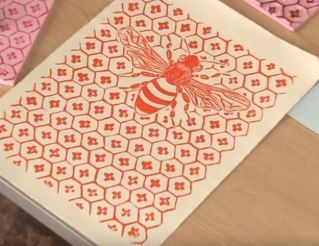
HOW TO MAKE A LINOLEUM BLOCK PRINT Watch how-to videos for beginners explaining the basic step-by-step process of making a linoleum block print.
HOW TO MAKE A BORO BAG Learn how to make a stand-out bag using a Japanese patchwork technique and Sashiko stitching.
'KNIT' LIKE THE VIKINGS Discover an ancient fabric-making technique that's still done today, pre-dates knitting, and doesn't unravel.

MAGNETIC CLAY CERAMICS Ceramic artists working with magnetic clay can play with the forces of nature to create fantastical structures.


